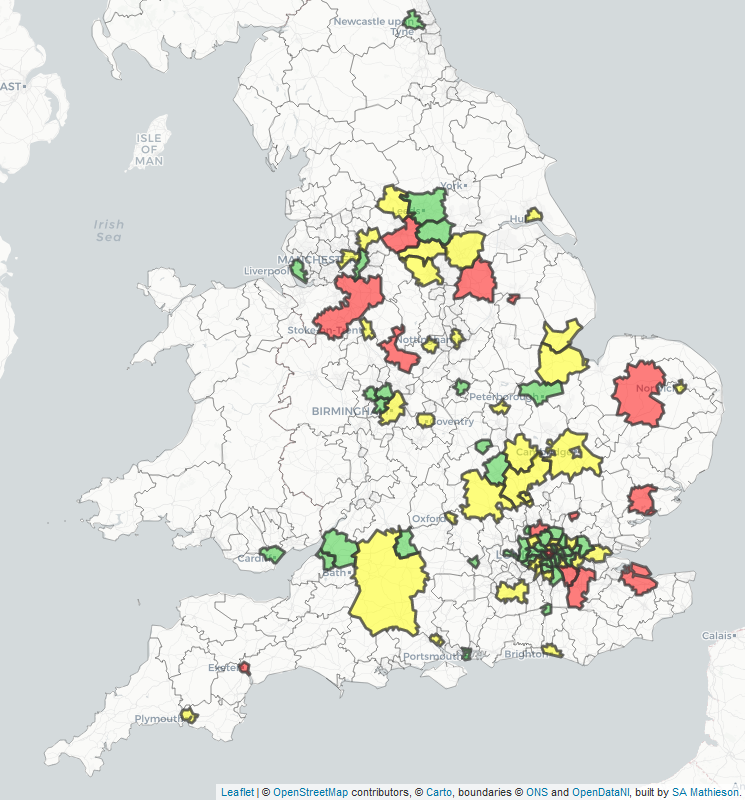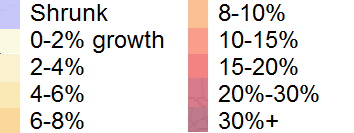Good to see that a team including George Bennett at the BBC and Leo Falcomer-Dawson at Bloomberg have set up Covid Live UK, a similar population-adjusted map covering all of the UK rather than just England, updated daily. Nice to note the organisers eventually came to the same conclusion that I did, which is that shades of blue are the way to go.
Continue reading “Covid-19 coronavirus in England mapped by cases per million”
Category: Data
EU Settlement Scheme needs to level-up locally
It would be nice if all data was easily comparable and highly accurate, but it’s not. Office for National Statistics numbers on nationality of people in local authority areas are rounded to the nearest thousand to reflect the fact they are survey-based estimates. The ONS recently pointed out a range of problems involved in comparing this dataset to Home Office data on applications to the EU Settlement Scheme.
I still made these comparisons for PublicTechnology, because the differences between areas are huge. Excluding Irish citizens (who generally don’t need to apply to stay in the UK post-Brexit), the number of applications to the EU Settlement Scheme is equivalent to about three-quarters of 3.6 million European citizens in the UK. But for Bassetlaw in Nottinghamshire and Sevenoaks in Kent, it is around one-quarter.
 Continue reading “EU Settlement Scheme needs to level-up locally”
Continue reading “EU Settlement Scheme needs to level-up locally”
Robot markers and online submissions: what will exam assessments look like in the future?
Article by SA Mathieson, Guardian Labs, (Transforming the student experience series paid for by Jisc), 20 February 2020
Throughout their study, students today routinely use virtual learning environments, online resources and other digital services. But at the end of their courses, many will be assessed using an old-school method: answers written with pen and paper in a few high-stakes hours.
“We’ve got quite an old-fashioned assessment system that hasn’t kept pace with student expectations,” says Chris Cobb, pro vice-chancellor of the University of London. “I don’t think I could write a start-to-finish essay with a pen nowadays. I don’t write like that any more.” Continue reading “Robot markers and online submissions: what will exam assessments look like in the future?”
How cloud computing helped one university to digitise the student experience
Article by SA Mathieson, Guardian Labs, (The Connected University series paid for by Staffordshire University), 4 December 2019
Until recently, a university that wished to remind students about lectures, answer their questions around the clock and provide personalised suggestions on which societies to join would have needed a call centre of support staff working shifts. Staffordshire University is now providing all of these services and others through its app, Beacon, a digital coach for students available on mobile devices accessed through voice and text. Continue reading “How cloud computing helped one university to digitise the student experience”
Littler Britain: the 14 council areas with falling populations
The Office for National Statistics has just published its annual population estimates for mid-2018. I have updated a map I first produced two years ago, showing how each area’s population has changed between 2008 and 2018. As well as the colour-coding, you can see the percentage change by hovering over an area. The data is derived from sheet MYE5 of this spreadsheet.
There are 14 council areas whose populations have fallen over the decade (shown in blue), while the UK’s population as whole grew by 7.5%. Most of them are rural and coastal areas: in England they include Cumbria, the Isles of Scilly and (an exception to the rural bit) Blackpool; in Wales, Ceredigion, Powys and Blaenau Gwent. In Scotland, seven council areas have fallen in population, mostly on the west coast: Argyll and Bute, Dumfries and Galloway, Na h-Eileanan Siar (the Western Isles), Inverclyde, North Ayrshire, South Ayrshire and West Dunbartonshire.

Continue reading “Littler Britain: the 14 council areas with falling populations”
